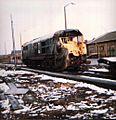British Rail Class 31 facts for kids
Quick facts for kids Brush Type 2British Rail Class 31 |
|
 |
|
| 31289 at the Northampton & Lamport Railway, 22 April 2007 | |
| Power type | Diesel-electric |
|---|---|
| Builder | Brush Traction |
| Build date | 1957–1962 |
| Configuration | A1A-A1A |
| UIC classification | (A1A)'(A1A)' |
| Gauge | 4 ft 8 1⁄2 in (1,435 mm) |
| Wheel diameter | Driving: 3 ft 7 in (1.092 m) Idling: 3 ft 3+1⁄2 in (1.003 m) |
| Minimum curve | 4.5 chains (91 m) |
| Wheelbase | 42 ft 10 in (13.06 m) |
| Length | 56 ft 9 in (17.30 m) |
| Width | 8 ft 9 in (2.67 m) |
| Height | 12 ft 7 in (3.84 m) |
| Locomotive weight | 106.7 long tons (108.4 t) to 113 long tons (115 t) |
| Fuel capacity | 650 imp gal (3,000 L; 780 US gal) |
| Prime mover | Original: Mirrlees JVS12T Rebuilt: English Electric 12SVT |
| Transmission | DC generator, DC traction motors |
| Multiple working | D5500–D5519: ● Red Circle Remainder: ★ Blue Star |
| Top speed | D5500–5534: 80 mph (129 km/h) Remainder: 90 mph (145 km/h) |
| Power output | Engine: 1,470 bhp (1,100 kW) At rail: 872 hp (650 kW) |
| Tractive effort | Maximum: 35,900 lbf (159,691 N) |
| Train heating | 31/0 & 31/1: Steam generator 31/4: Electric Train Heat |
| Locomotive brakeforce | 49 long tons-force (488 kN) |
| Train brakes | Vacuum |
| Career | British Railways |
| Number | D5500–D5699, D5800–D5862, later 31001–31970 |
| Axle load class | Route availability 5 |
The British Rail Class 31 diesel locomotives are a type of powerful train. They were also known as the Brush Type 2 and first called Class 30. These trains were built by a company called Brush Traction. Construction happened between 1957 and 1962.
Contents
What is the Class 31 Locomotive?
The Class 31 is a type of diesel-electric locomotive. This means it uses a diesel engine to power a generator. The generator then makes electricity. This electricity powers motors that turn the wheels.
Building These Powerful Trains
Brush Traction built 263 of these locomotives. They were designed to be general-purpose trains. This means they could pull many different types of trains. They were used for both passenger and freight services.
How the Class 31 Works
The Class 31 locomotives have a special wheel arrangement. It's called A1A-A1A. This means each bogie (the wheel set under the train) has three axles. Only the outer two axles on each bogie are powered. The middle axle is not powered. This design helps the train spread its weight. It also allows it to travel on lighter railway tracks.
Engines and Power
When first built, these trains used a Mirrlees JVS12T engine. Later, many of them were rebuilt. They received a different engine, the English Electric 12SVT. This engine helped improve their performance. The trains could reach speeds of 80 or 90 miles per hour.
What Were Class 31s Used For?
Class 31s were very versatile. They pulled passenger trains across the country. They also hauled heavy freight trains. Some were even used for special test trains. They were a common sight on British railways for many years.
Different Versions of the Class 31
Over time, some Class 31s were changed. Some had steam generators to heat passenger coaches. Others were updated with electric train heating. This allowed them to pull modern passenger trains. Different versions were given numbers like 31/0, 31/1, and 31/4.
Class 31s Today
Many Class 31 locomotives have now been retired. However, some are still in use today. You can find them on heritage railways. These are special railways where old trains are preserved. Some are also used by private companies for special tasks. One famous Class 31, number 31 107, was even used in a TV show.
Preserved Locomotives
You can see preserved Class 31s at places like the National Railway Museum in York. The very first Class 31, number 31018, is there. It shows what these trains looked like when they were new. Other Class 31s are still running on heritage lines. They let people experience these classic trains.
Images for kids
-
31018, at the National Railway Museum in York, on 3 June 2004. This was the first locomotive of the Class to be built in 1957. It was withdrawn from service in 1976. It currently carries BR Blue livery. Note the absence of over-window head code panel, which were only omitted from the first few locomotives.
-
31271 Stratford 1840-2001, pictured on 3 June 2004 at the York Railfest held to celebrate the 200th anniversary of railways. Under the auspices of A1A Locomotives Limited, the locomotive will be spending the 2019 and 2020 seasons on the Llangollen Railway in North Wales.
-
31128 Charybdis at Bristol Temple Meads on 23 July 2004. This locomotive was owned by Fragonset Railways, but hired to Wessex Trains to haul trains from Bristol to Brighton and Weymouth.
-
InterCity liveried 31414 running brake van rides on the Ecclesbourne Valley Railway.
-
Regional Railways livery 31270 at Peak Rail, Rowsley, Derbyshire.
-
Network Rail 31285 speeds through Rugeley working a test train.
-
31601 in Devon and Cornwall Railways green livery, working a Network Rail test train south of Chesterfield.

















